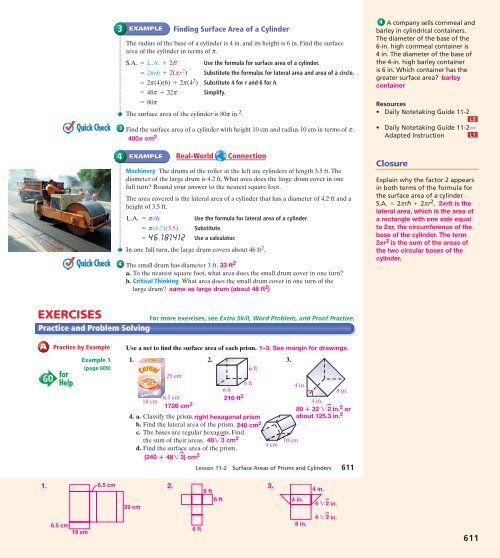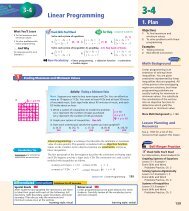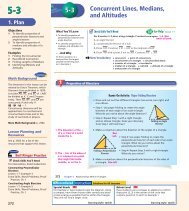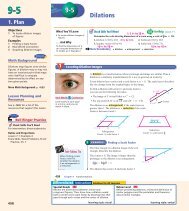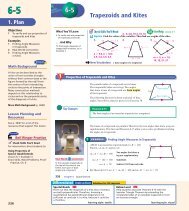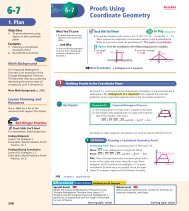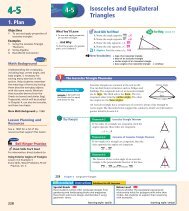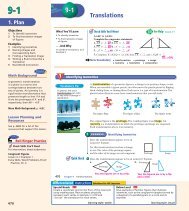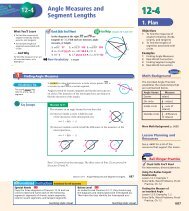You also want an ePaper? Increase the reach of your titles
YUMPU automatically turns print PDFs into web optimized ePapers that Google loves.
Quick Check<br />
Quick Check<br />
Example 1<br />
(page 609)<br />
3<br />
4<br />
EXAMPLE<br />
Finding Surface Area of a Cylinder<br />
The radius of the base of a cylinder is 4 in. and its height is 6 in. Find the surface<br />
area of the cylinder in terms of p.<br />
S.A. = L.A. + 2B Use the formula for surface area of a cylinder.<br />
= 2prh + 2(pr 2 ) Substitute the formulas for lateral area and area of a circle.<br />
= 2p(4)(6) + 2p(4 2 ) Substitute 4 for r and 6 for h.<br />
= 48p + 32p Simplify.<br />
= 80p<br />
The surface area of the cylinder is 80p in. 2 .<br />
3 Find the surface area of a cylinder with height 10 cm and radius 10 cm in terms of p.<br />
400 cm2 π<br />
EXAMPLE Real-World Connection<br />
Machinery The drums of the roller at the left are cylinders of length 3.5 ft. The<br />
diameter of the large drum is 4.2 ft. What area does the large drum cover in one<br />
full turn? Round your answer to the nearest square foot.<br />
The area covered is the lateral area of a cylinder that has a diameter of 4.2 ft and a<br />
height of 3.5 ft.<br />
L.A. = pdh Use the formula for lateral area of a cylinder.<br />
= p(4.2)(3.5) Substitute.<br />
= 46.181412 Use a calculator.<br />
In one full turn, the large drum covers about 46 ft 2 .<br />
The small drum has diameter 3 ft.<br />
a. To the nearest square foot, what area does the small drum cover in one turn?<br />
b. Critical Thinking What area does the small drum cover in one turn of the<br />
large drum? same as large drum (about 46 ft2 4<br />
33 ft<br />
)<br />
2<br />
EXERCISES<br />
For more exercises, see Extra Skill, Word Problem, and Proof Practice.<br />
Practice and Problem Solving<br />
A<br />
Practice by Example<br />
GO for<br />
Help<br />
Use a net to find the surface area of each prism.<br />
1. 2. 3.<br />
4. a. Classify the prism.<br />
b. Find the lateral area of the prism.<br />
c. The bases are regular hexagons. Find<br />
the sum of their areas. 48 cm2 6 ft<br />
29 cm<br />
6 ft<br />
6 ft<br />
4 in.<br />
8 in.<br />
6.5 cm<br />
19 cm<br />
1726 cm<br />
4 in.<br />
"3<br />
d. Find the surface area of the prism.<br />
4 cm<br />
10 cm<br />
2<br />
216 ft2 1–3. See margin for drawings.<br />
right hexagonal prism<br />
80 ± 32 in. 2 or<br />
about 125.3 in. 2<br />
240 cm<br />
"2<br />
2<br />
(240 ± 48 ) cm2 "3<br />
Lesson 11-2 Surface Areas of Prisms and Cylinders 611<br />
1. 6.5 cm<br />
2. 3.<br />
6 ft<br />
6 ft<br />
29 cm<br />
6.5 cm<br />
19 cm<br />
6 ft<br />
4 in.<br />
8 in.<br />
4 in.<br />
4 "2<br />
in.<br />
4 "2 in.<br />
4 A company sells cornmeal and<br />
barley in cylindrical containers.<br />
The diameter of the base of the<br />
6-in. high cornmeal container is<br />
4 in. The diameter of the base of<br />
the 4-in. high barley container<br />
is 6 in. Which container has the<br />
greater surface area? barley<br />
container<br />
Resources<br />
• Daily Notetaking Guide 11-2<br />
L3<br />
• Daily Notetaking Guide 11-2—<br />
Adapted Instruction L1<br />
Closure<br />
Explain why the factor 2 appears<br />
in both terms of the formula for<br />
the surface area of a cylinder<br />
S.A. = 2prh + 2pr 2 . 2πrh is the<br />
lateral area, which is the area of<br />
a rectangle with one side equal<br />
to 2πr, the circumference of the<br />
base of the cylinder. The term<br />
2πr 2 is the sum of the areas of<br />
the two circular bases of the<br />
cylinder.<br />
611


